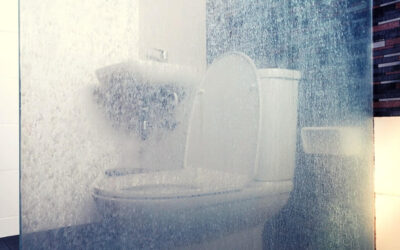Are you looking for alternative ways how to clean shower head without vinegar?
Vinegar is a common household product that is readily available. It is an excellent cleaning solvent that not only removes stains but also freshens a room by absorbing bad smells.
For years, vinegar has been used to clean clogged and dirty showerheads because it does not contain harmful chemicals.
However, if you don’t have vinegar, you can try other delicate cleaning agents and solvents that are also readily available.
Therefore in this article, we shall discuss how to remove scum, grime, and hard water build-up on showerheads using baking soda, lemon juice, and oven cleaner.
How to clean shower head without vinegar
1. Using baking soda
Baking soda is a non-toxic and affordable alternative to vinegar when it comes to cleaning showerheads and other surfaces at home.
It helps to unclog the showerhead by removing limescale build-up. In addition, baking soda has antibacterial properties; hence, it kills bacteria and germs on the showerhead.
To use the baking soda to clean a clogged showerhead, mix it with warm water in the ratio of 1:1.
Apply the paste on the showerhead in that it covers the entire head, including the holes.
Give it at least thirty minutes and rinse thoroughly using clean water. Please note that if any baking soda particles remain on the showerhead, they might cause further clogging.
Therefore, ensure that you have rinsed off all the baking soda, especially on the holes, and confirm that the showerhead is working properly.
2. Lemon juice
Lemon juice is acidic so it is a good alternative to vinegar, which is also acidic.
You can choose to buy a readily prepared bottle of lemon juice or get some fresh lemons and squeeze the juice.
To clean the showerhead, simply dip a soft cloth or paper towel into the lemon juice and rub it gently on the showerhead.
Be careful not to scrub or rub too hard so as not to damage the showerhead.
To get excellent results, consider adding salt to the lemon juice and mix it thoroughly. This will advance the acidic component’s concentration in cleaning the grime and excess mildew, thus unclogging your shower head.
After applying the lemon juice, give it some time, and then rinse it with water. Your showerhead is clean and ready for use.
3. Wet and forget shower cleaner
Wet and Forget shower cleaner can be used to clean your showerhead. Simply mist or spray it on the head and let it sit for a while.
For best results, scrub off any build-up with a toothbrush to remove build-up and gunk.
Finish off by rinsing with clean water. Repeat if necessary.
4. Hydrogen peroxide
A common question people often ask is; can you use hydrogen peroxide to clean a shower head?
The answer is yes, you can use hydrogen peroxide to clean a shower head. It’s a good way to get rid of mold and mildew.
To clean a shower head with hydrogen peroxide, mix equal parts hydrogen peroxide and water in a spray bottle.
Spray the mixture directly onto the shower head and let it sit for 10-15 minutes.
Rinse the shower head with warm water and enjoy the fresh, clean smell.
5. Oven cleaner
Oven cleaner is a standardized cleaning agent that contains sensitive chemical components. It can effortlessly eliminate any form of dirt on surfaces and appliances around the house.
However, care should be taken when using it. So before you start cleaning the showerhead, ensure the room is well ventilated and wear gloves and a mask.
Easy off professional fume-free max oven cleaner comes highly recommended for cleaning hard water stains on showerheads and bathtubs. Also, it does not produce toxic fumes.
When using oven cleaner to clean the showerhead, there is no need to remove it from the fixture.
Just start by spraying the oven cleaner all over the showerhead, especially around the holes. Let it sit overnight for the dirt and stains to loosen and then rinse off with clean water.
Wipe off the showerhead and give it time to air-dry.
See also: How to remove brown stains in enamel bathtub
6. Limescale remover
Descaling a showerhead can be a bit tricky, but it’s definitely doable. Here are the steps:
- Remove the showerhead from the wall.
- Pour limescale remover into a small bowl or cup. Consider using CLR Calcium, Lime, Rust Remover, which is a multipurpose cleaner designed for all bathroom and kitchen related surfaces.
- Dip the end of a toothbrush into the limescale remover, and then scrub away at the build-up on the showerhead until it’s gone.
- Rinse off the showerhead with warm water to remove all traces of the limescale remover.
- Reattach the showerhead to the wall and enjoy your newly descaled shower.
7. Bleach
Can you use bleach to clean a shower head? Of course, you can.
Bleach is an affordable and accessible household cleaning solvent and a strong disinfectant.
It works particularly fine on plastic showerheads but it can also be used on metal ones to whiten and brighten them.
There are two ways you can clean with bleach. One is to take a polythene bag, fill it with bleach and tie it around the showerhead. Leave it there overnight and check the results in the morning.
Don’t be surprised to find whitish filth in the bag. It’s the hard water build-up and scum from the showerhead that seeped into the bleach.
Carefully remove the bag, throw it away and rinse the showerhead thoroughly with clean water.
The second option is to mix bleach with water in a ratio of 1:1. Apply it to the showerhead using a soft piece of cloth and leave it for about five minutes. Rinsing it off and then clean the showerhead with mild soap and rinse again thoroughly.
Please note that bleach should be used with a lot of caution by working in a well-ventilated area. Also, do not mix bleach with any other cleaning agent since it is hazardous.
See also: Best bath mat for reglazed and refinished tub
What causes buildup on shower head?
The minerals in hard water are the most common cause of buildup on shower heads.
Hard water is water that has a high concentration of minerals, such as calcium and magnesium.
These minerals can form a layer of scale on the shower head, which can lead to decreased water pressure and decreased performance.
The best way to prevent this is by installing a shower head filter, which will remove these minerals from the water.
You can also descale your shower head regularly to remove any build-up that has already formed.
See also: How to make shower water hotter
How do you descale a shower head and remove calcium deposits?
You can descale your shower head by using a vinegar and water solution.
Simply mix equal parts vinegar and water in a bowl, and then submerge your shower head in the mixture. Let it soak for a few hours, and then scrub away any remaining deposits with a brush.
How do you remove thick limescale from shower head without vinegar?
You can remove limescale from a showerhead without vinegar using a limescale remover.
There are a few ways to descale a shower head using limescale remover.
One way is to fill a bag with limescale remover, tie the bag shut, and submerge the shower head in the bag for several hours.
Another way is to pour limescale remover into a bowl and soak the shower head in the bowl for several hours.
A third way is to use a toothbrush to apply limescale remover to all of the areas of the shower head that are covered in lime build-up.
Whichever option you choose, let the limescale remover sit on the showerhead for several hours before rinsing it off with water.
Finally, make sure to thoroughly rinse off the limescale remover from the shower head.
How do I clean a corroded shower head?
There are a few ways to clean a corroded shower head. You can try using vinegar, CLR remover, or a baking soda and water paste.
If the shower head is removable, you can also soak it in a vinegar or CLR solution.
If the shower head is not removable, you can try spraying it with a vinegar or CLR solution.
Another option is to make a baking soda and water paste, apply it to the shower head, and let it sit for 30 minutes before rinsing off.
How do I keep my shower head from clogging?
The best way to keep your shower head from clogging is to clean it regularly.
You can do this by soaking it in a vinegar solution or using a toothbrush to scrub away any build-up.
Additionally, make sure that you’re using a quality shower head filter to keep water impurities from causing problems.
What do you spray in shower after every use?
I usually just spray water around the shower after each use.
Sometimes I’ll add a little bit of vinegar or lemon juice if I’m feeling like I need to disinfectant.
I mix one part vinegar or lemon juice with three parts water in a spray bottle and keep it in my shower. This helps to prevent mold and mildew from growing in my shower.
Conclusion
Many people strongly believe in cleaning their shower heads with vinegar, but there are multiple ways how to clean your shower head without vinegar.
It is important to remember that the moisture in the bathroom tends to create a favorable environment for the growth of mold and bacteria, resulting in the clogging of the showerhead.
Also, hard water, soap, and grime build contribute to the clogging of showerheads.
It is therefore important to clean your showerhead regularly.
If you don’t have vinegar, try baking soda, lime juice, bleach, limescale remover, or oven cleaner. Just choose the one that is readily available to you.







